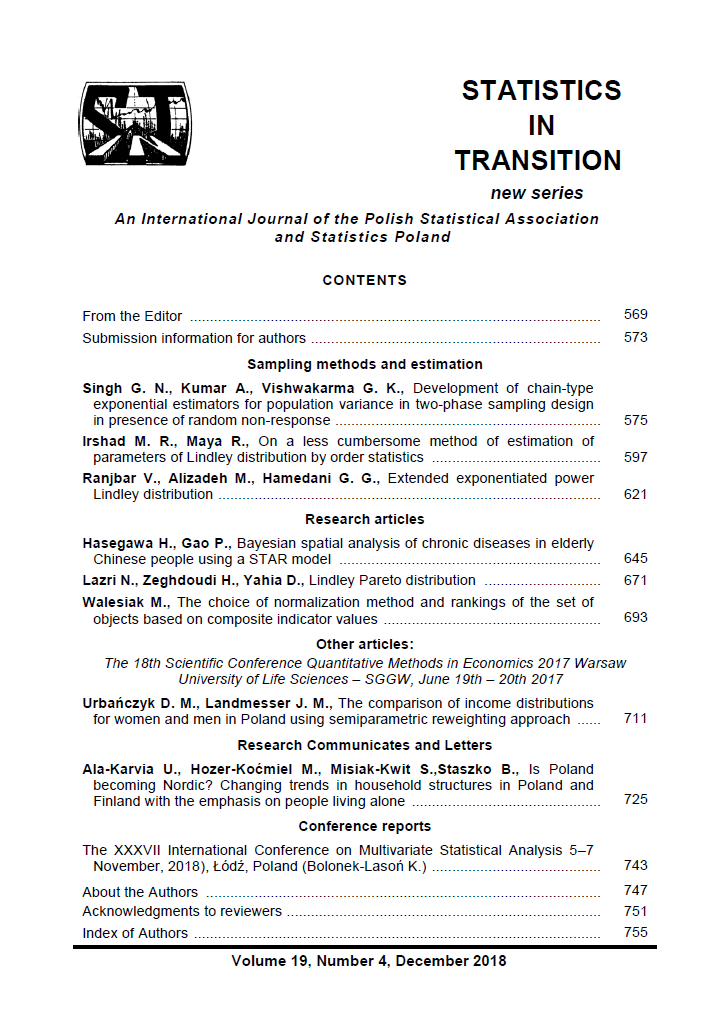ARTICLE
ABSTRACT
In this paper, an investigation has been carried out to deal with a unified approach of estimation procedures of population variance in two-phase sampling design under missing at random non-response mechanism circumstances. Using two auxiliary variables, we have developed different chain-type exponential estimators of finite population variance for two different set-ups and studied their properties under the different assumption of random non-response considered by Tracy and Osahan (1994). The comparisons of the proposed estimators have been made with some contemporary estimators of population variance under the similar realistic conditions. Numerical illustrations are presented to support the theoretical results. Results are analysed and suitable recommendations are put forward to the survey statisticians.
KEYWORDS
two-phase sampling, random non-response, variance estimation, study variable, auxiliary information, bias, mean square error
REFERENCES
AHMED, M. S., ABU-DAYYEH, W., HURAIRAH, A. A. O., (2003). Some estimators for population variance under two phase sampling. Statistics in Transition, 6 (1), pp. 143–150.
AHMAD, Z., ALI, S., HANIF, M., (2013). Variance estimation in two-phase sampling using multi-auxiliary variables in the presence of non-response. Pakistan Journal of Statistics, 29 (4), pp. 487–501.
BANDYOPADHYAY, A., SINGH, G. N., (2015). Estimation of Population Variance in Two-Phase Sampling in Presence of Random Non-Response. Pakistan Journal of Statistics and Operation Research, 11 (4), pp. 525–542.
BIRADAR, R. S., SINGH, H. P., (1994). An alternative to ratio estimator of population Variance. Assam Statistical Review, 8 (2), pp. 18–33.
CHAND, L., (1975). Some ratio-type estimators based on two or more auxiliary variables. Ph. D. dissertation, Iowa State University, Ames, Iowa.
DAS, A. K., TRIPATHI, T. P., (1978). Use of auxiliary information in estimating the finite population variance. Sankhya, 40(C), pp. 139–148.
HANSEN, M. H., HURWITZ, W. N., (1946). The problem of non response in sample surveys. Journal of the American Statistical Association, 41, pp. 517–529.
HEITZAN, D. F., BASU, S., (1996). Distinguish ‘Missing at Random’ and ‘Missing Completely at Random’, The American Statistician, 50, pp. 207–217.
ISAKI, C. T., (1983). Variance estimation using auxiliary information. Journal of American Statistical Association, 78, pp. 117–123.
KIREGYERA, B., (1980). A chain ratio-type estimator in finite population double sampling using two auxiliary variables. Metrika, 27, pp. 217–223.
MUKHERJEE, R., RAO, T. J., VIJAYAN, K., (1987). Regression type estimators using multiple auxiliary information. Australian & New Zealand Journal of Statistics, 29, pp. 244–254.
MURTHY, M. N., (1967). Sampling Theory and Methods. Statistical Publishing Society Calcutta, India.
PRADHAN, B. K., (2005). A chain regression estimator in two-phase sampling using multi-auxiliary information. Bulletin of the Malaysian Mathematical Science Society, 28 (1), pp. 81–86.
RUBIN, D. B., (1976). Inference and missing data. Biometrika, 63 (3), pp. 581–592.
SATICI, E., KADILAR, C., (2011). Ratio estimator for the population mean at the current occasion in the presence of non-response in successive sampling. Hacettepe Journal of Mathematics and Statistics, 40 (1), pp. 115–124.
SINGH, G. N., MAJHI, D., (2014). Some chain-type exponential estimators of population mean in two-phase sampling, Statistics in Transition, 15 (2),pp. 221–230.
SINGH, G. N., UPADHYAYA, L. N., (1995). A class of modified chain type estimators using two auxiliary variables in two-phase sampling, Metron, LIII,pp. 117–125.
SINGH, H. P., TRACY, D. S., (2001). Estimation of population mean in presence of random non-response in sample surveys, Statistica, LXI, pp. 231–248.
SINGH, H. P., CHANDRA, P., SINGH, S., (2003). Variance estimation using multiauxiliary information for random non-response in survey sampling. Statistica, LXIII, pp. 23–40.
SINGH, H. P., CHANDRA, P., JOARDER, A. H., SINGH, S., (2007). Family of estimators of mean, ratio and product of a finite population using random non response, Test. 16, pp. 565–597.
SINGH, H. P., TAILOR, R., KIM, J. M., SINGH, S., (2012). Families of estimators of finite population variance using a random non-response in survey sampling. The Korean Journal of Applied Statistics, 25 (4), pp. 681–695.
SINGH, H. P., VISHWAKARMA, G. K., (2007). Modified exponential ratio and product estimators for finite population mean in double sampling. Austrian Journal of Statistics, 36 (3), pp. 217–225.
SINGH, R. K., (1983). Estimation of finite population variance using ratio and product method of estimation. Biometrika, 25 (2), pp. 193–200.
SINGH, S., JOARDER, A. H., (1998). Estimation of finite population variance using random non-response in survey sampling. Metrika, 98, pp. 241–249.
SINGH, S., JOARDER, A. H., TRACY, D. S., (2000). Regression type estimators for random non-response in survey sampling. Statistica, LX (1), pp. 39–43.
SRIVASTAVA, S. K., JHAJJ, H. S., (1980). A class of estimators using auxiliary information for estimating finite population variance. Sankhya, C, 42 (1–2),pp. 87–96.
SUKHATME, P. V., SUKHATME, B. V., (1970). Sampling Theory of Survey with Applications. Asia Publishing House. India.
TRACY, D. S., OSAHAN, S. S., (1994). Random non-response on study variable versus on study as well as auxiliary variables. Statistica, 54, pp. 163–168.
TRIPATHI, T. P., SINGH, H. P., UPADHYAYA, L. N., (1988). A generalized method of estimation in double sampling. Journal of Indian Statistical Association, 26, pp. 91–101.
UPADHYAYA, L. N., SINGH, H. P., (1983). Use of auxiliary information in the estimation of population variance. Mathematical Forum, 6 (2), pp. 33–36.
UPADHYAYA, L. N., SINGH, H. P., (2006). Almost unbiased ratio and product type estimators of finite population variance in sample surveys. Statistics in Transition, 7 (5), pp. 1087–1096
